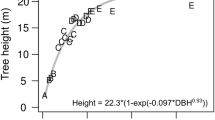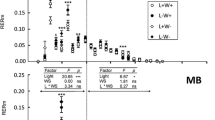Abstract
Key message
In adult walnut trees, poor light environments increase the number of catkins on a shoot, reducing the probability of bearing fruits. Growth units become shorter with the aging of the tree, tending to reach a stable length.
Abstract
Tree architecture results from the functioning of populations of meristems across consecutive periods of extension or growing cycles. The study of growth units (GUs) and the type of their axillary meristem lead to a better understanding of tree growth and allow the prediction of tree development under different environmental conditions. To study the effect of position inside the canopy on branch development and the relationship between parent wood and new shoots, 348 GUs from 14 five-to-six-year-old limbs (7 from upper/exposed and 7 from lower/shaded zones within the canopy) were analyzed. Each node was classified according to its axillary meristem type as: 0 (bud, dormant bud, bud scar and dead bud), 1 (fruit and fruit peduncle scar), 2 (male inflorescence or “catkin”, catkin scar and dead catkin) and 3 (branch and branch scar). Data were analyzed through a multinomial logistic model to summarize the distribution of axillary meristem type as a function of explanatory variables. Length of GUs and the number of catkins were modeled through a generalized linear mixed model, whereas the probability of finding fruit on apical nodes was analyzed through generalized additive models. Results show that axillary meristem type is affected by zone, node rank and wood age. On GUs of wood age two or younger, apical buds from upper/exposed zones showed higher probabilities of producing fruits compared with apical buds from lower/shaded zones. The latter was not observed for older wood. In upper/exposed zones, the slope of the relationship between the length of GUs and the length of parent wood increased with wood age. The number of catkins was higher in the lower/shaded than in the upper/exposed zone. The results of this study improve our understanding about walnut tree growth as affected by factors like ontogenetic changes and different light conditions within the tree canopy and might be useful to address tree managements such as training and pruning systems.








Similar content being viewed by others
References
Barbier FF, Dun EA, Kerr SC, Chabikwa TG, Beveridge CA (2019) An update on the signals controlling shoot branching. Trends Plant Sci 24(3):220–236. https://doi.org/10.1016/j.tplants.2018.12.001
Barlow PW (1989) Meristems, metamers and modules and the development of shoot and root systems. Bot J Linn Soc 100(3):255–279. https://doi.org/10.1111/j.1095-8339.1989.tb01721.x
Barthélémy D, Caraglio Y (2007) Plant architecture: a dynamic, multilevel and comprehensive approach to plant form, structure and ontogeny. Ann Bot 99(3):375–407. https://doi.org/10.1093/aob/mcl260
Chen L, Sumida A (2017) Patterns of branch growth and death in crowns of sakhalin spruce, Picea glehnii (F. Schmidt) Mast. Forests. https://doi.org/10.3390/f8010026
Costes E, Guedon Y (1997) Modeling the sylleptic branching on one-year-old trunks of apple cultivars. J Am Soc Hort Sci 122(1):53–62. https://doi.org/10.21273/JASHS.122.1.53
Costes E, Guedon Y (2002) Modelling branching patterns on 1-year-old trunks of six apple cultivars. Ann Bot 89(5):513–524. https://doi.org/10.1093/aob/mcf078
Costes E, Guedon Y (2012) Deciphering the ontogeny of a sympodial tree. Trees-Struct Funct 26(3):865–879. https://doi.org/10.1007/s00468-011-0661-8
Costes E, Sinoquet H, Kelner JJ, Godin C (2003) Exploring within-tree architectural development of two apple tree cultivars over 6 years. Ann Bot 91(1):91–104. https://doi.org/10.1093/aob/mcg010
Courbet F, Sabatier S, Guedon Y (2007) Predicting the vertical location of branches along Atlas cedar stem (Cedrus atlantica Manetti) in relation to annual shoot length. Ann Forest Sci 64(7):707–718. https://doi.org/10.1051/forest:2007051
Ducousso I, Sabatier S, Barthélémy D, Germain E (1995) Comparaison de quelques caractéristiques morphologiques des pousses annuelles et des branches de la cime de sept variétés de noyer commun, Juglans regia L. (Juglandaceae), in: Colloque sur l’architecture des arbres fruitiers et forestiers. (Montpellier, 23–25 Nov. 1993. Ed. J. Bouchon, Editions INRA, Versailles, Les Colloques no. 74, 91–108
Fernandez E, Baird G, Farias D, Oyanedel E, Olaeta JA, Brown P et al (2018) Fruit load in almond spurs define starch and total soluble carbohydrate concentration and therefore their survival and bloom probabilities in the next season. Sci Hortic 237:269–276. https://doi.org/10.1016/j.scienta.2018.04.030
Fortanier EJ, Jonkers H (1976) Juvenility and maturity of plants as influenced by their ontogenetical and physiological ageing. Acta Hort 56:37–44. https://doi.org/10.17660/ActaHortic.1976.56.2
Gao Y, Liu H, Pei D (2014) Morphological characteristics and in situ auxin production during the histogenesis of staminate flowers in precocious walnut. J Am Soc Hort Sci 139(2):185–190. https://doi.org/10.21273/JASHS.139,2.185
Garcia-Martinez JL, Gil J (2001) Light regulation of gibberellin biosynthesis and mode of action. J Plant Growth Regul 20(4):354–368. https://doi.org/10.1007/s003440010033
Guedon Y, Barthélémy D, Caraglio Y, Costes E (2001) Pattern analysis in branching and axillary flowering sequences. J Theor Biol 212(4):481–520. https://doi.org/10.1006/jtbi.2001.2392
Hackett WP (2011) Juvenility, maturation, and rejuvenation in woody plants. Hort Rev. https://doi.org/10.1002/9781118060735.ch3
Hallé F, Martin R (1968) Etude de la croissance rythmique chez l’hevea (Hevea brasiliensis Muell Arg.) Euphorbiacees-Crotonoidees. Adansonia ser 8:475–503
Hallé F, Oldeman R, Tomlinson P (1978) Tropical trees and forests. Springer-Verlag, Berlin, p 441
Henriksson J (2001) Differential shading of branches or whole trees: survival, growth, and reproduction. Oecologia 126(4):482–486. https://doi.org/10.1007/s004420000547
Heuret P, Guedon Y, Guerard N, Barthélémy D (2003) Analysing branching pattern in plantations of young red oak trees (Quercus rubra L., Fagaceae). Ann Bot 91(4):479–492. https://doi.org/10.1093/aob/mcg046
Kelc D, Stampar F, Solar A (2007) Fruiting behaviour of walnut trees influences the relationship between the morphometric traits of the parent wood and nut weight. J Horticult Sci Biotechnol 82(3):439–445. https://doi.org/10.1080/14620316.2007.11512256
Kelc D, Stampar F, Solar A (2010) Architectural traits of fruiting shoots in Juglans regia (Juglandaceae) related to fruiting habit and environmental conditions. Aust J Bot 58(2):141–148. https://doi.org/10.1071/bt09095
Kottek M, Grieser J, Beck C, Rudolf B, Rubel F (2006) World map of the Koppen-Geiger climate classification updated. Meteorol Z 15(3):259–263. https://doi.org/10.1127/0941-2948/2006/0130
Langrová V, Sladký Z (1971) The role of growth regulators in the differentiation of walnut buds (Juglans regia L.). Biol Plant 13(5):361–367. https://doi.org/10.1007/bf02930925
Lauri PE, Maguylo K, Trottier C (2006) Architecture and size relations: an essay on the apple (Malus X Domestica, Rosaceae) tree. Am J Bot 93:357–368. https://doi.org/10.3732/ajb.93.3.357
Maguylo K, Cook NC, Theron KI (2012) Environment and position of first bud to break on apple shoots affects lateral outgrowth. Trees-Struct Funct 26(2):663–675. https://doi.org/10.1007/s00468-011-0634-y
Negron C, Contador L, Lampinen BD, Metcalf SG, Guedon Y, Costes E et al (2014) Differences in proleptic and epicormic shoot structures in relation to water deficit and growth rate in almond trees (Prunus dulcis). Ann Bot 113(3):545–554. https://doi.org/10.1093/aob/mct282
Negron C, Contador L, Lampinen BD, Metcalf SG, Guedon Y, Costes E et al (2015) How different pruning severities alter shoot structure: a modelling approach in young ‘Nonpareil’ almond trees. Funct Plant Biol 42(3):325–335. https://doi.org/10.1071/fp14025
Polito VS, Pinney K (1997) The relationship between phenology of pistillate flower organogenesis and mode of heterodichogamy in Juglans regia L (Juglandaceae). Sex Plant Reprod 10(1):36–39. https://doi.org/10.1007/s004970050065
Rameau C, Bertheloot J, Leduc N, Andrieu B, Foucher F, Sakr S (2015) Multiple pathways regulate shoot branching. Front Plant Sci. https://doi.org/10.3389/fpls.2014.00741
Ramos DE (1997) Walnut production manual. University of California, Oakland, p 328
Renton M, Guedon Y, Godin C, Costes E (2006) Similarities and gradients in growth unit branching patterns during ontogeny in ‘Fuji’ apple trees: a stochastic approach. J Exp Bot 57(12):3131–3143. https://doi.org/10.1093/jxb/erl075
Ryugo K, Marangoni B, Ramos DE (1980) Light-intensity and fruiting effects on carbohydrate contents, spur development, and return bloom of hartley walnut. J Am Soc Hort Sci 105(2):223–227
Sabatier S, Barthélémy D (2001a) Annual shoot morphology and architecture in persian walnut, Juglans regia L. (Juglandaceae). Acta Hort 544:255–264. https://doi.org/10.17660/ActaHortic.2001.544.34
Sabatier S, Barthélémy D (2001b) Bud structure in relation to shoot morphology and position on the vegetative annual shoots of Juglans regia L. (Juglandaceae). Ann Bot 87(1):117–123. https://doi.org/10.1006/anbo.2000.1312
Samach A, Smith HM (2013) Constraints to obtaining consistent annual yields in perennials. II: environment and fruit load affect induction of flowering. Plant Sci 207:168–176. https://doi.org/10.1016/j.plantsci.2013.02.006
Schmitz JD, Guedon Y, Herter FG, Leite GB, Lauri PE (2014) Exploring bud dormancy completion with a combined architectural and phenological analysis: the case of apple trees in contrasting winter temperature conditions. Am J Bot 101(3):398–407. https://doi.org/10.3732/ajb.1300335
Seleznyova AN, Thorp TG, Barnett AM, Costes E (2002) Quantitative analysis of shoot development and branching patterns in Actinidia. Ann Bot 89(4):471–482. https://doi.org/10.1093/aob/mcf069
Solar A, Štampar F (2003) Genotypic differences in branching pattern and fruiting habit in common walnut (Juglans regia L.). Ann Bot 92(2):317–325. https://doi.org/10.1093/aob/mcg137
Solar A, Hudina M, Štampar F (2004) Fruiting habit and branching pattern affect vegetative growth and reproductive ability in walnut (Juglans regia L.). Acta Hort 663:387–392. https://doi.org/10.17660/ActaHortic.2004.663.66
Solar A, Solar M, Štampar F (2006a) Stability of the annual shoot diameter in Persian walnut: a case study of different morphotypes and years. Trees-Struct Funct 20(4):449–459. https://doi.org/10.1007/s00468-006-0060-8
Solar A, Solar M, Štampar F (2006b) Modelling the diameter of annual shoots in a three-year-old fruiting branch of persian walnut (Juglans regia L.). Acta Hort 707:85–91. https://doi.org/10.17660/ActaHortic.2006.707.10
Srikanth A, Schmid M (2011) Regulation of flowering time: all roads lead to Rome. Cell Mol Life Sci 68(12):2013–2037. https://doi.org/10.1007/s00018-011-0673-y
Stamm P, Kumar PP (2010) The phytohormone signal network regulating elongation growth during shade avoidance. J Exp Bot 61(11):2889–2903. https://doi.org/10.1093/jxb/erq147
Symons GM, Smith JJ, Nomura T, Davies NW, Yokota T, Reid JB (2008) The hormonal regulation of de-etiolation. Planta 227(5):1115–1125. https://doi.org/10.1007/s00425-007-0685-x
Takenaka A (2000) Shoot growth responses to light microenvironment and correlative inhibition in tree seedlings under a forest canopy. Tree Physiol 20(14):987–991
Taugourdeau O, Sabatier S (2010) Limited plasticity of shoot preformation in response to light by understorey saplings of common walnut (Juglans regia). Aob Plants. https://doi.org/10.1093/aobpla/plq022
Taugourdeau O, Chaubert-Pereira F, Sabatier S, Guedon Y (2011) Deciphering the developmental plasticity of walnut saplings in relation to climatic factors and light environment. J Exp Bot 62(15):5283–5296. https://doi.org/10.1093/jxb/err115
Valdebenito D, Farias D, Oyanedel E, Castro M, Lampinen B, Tixier A et al (2017) The morphology of a walnut (Juglans regia L.) shoot is affected by its position in the canopy and correlated to the number and size of its fruits. Sci Hortic 220:303–309. https://doi.org/10.1016/j.scienta.2017.03.046
Valdebenito D, Farias D, Lampinen B, Tixier A, Zwieniecki M, Saa S (2018) The position in the canopy and the bearing status of 1-year-old shoots affect the bearing potential and morphology of current-year shoots in walnuts (Juglans regia L.) cv. Chandler. Trees-Struct Funct 32(5):1267–1277. https://doi.org/10.1007/s00468-018-1708-x
Wahl V, Ponnu J, Schlereth A, Arrivault S, Langenecker T, Franke A et al (2013) Regulation of flowering by trehalose-6-phosphate signaling in Arabidopsis thaliana. Science 339(6120):704–707. https://doi.org/10.1126/science.1230406
Yang WW, Pallas B, Durand JB, Martinez S, Han MY, Costes E (2016) The impact of long-term water stress on tree architecture and production is related to changes in transitions between vegetative and reproductive growth in the ‘Granny Smith’ apple cultivar. Tree Physiol 36(11):1369–1381. https://doi.org/10.1093/treephys/tpw068
Acknowledgements
The authors would like to thank Mr. Giovanni Lobos from the Centro Experimental Choapa, Instituto de Investigaciones Agropecuarias (INIA) Intihuasi, Illapel, Chile, for his aid in this research.
Author information
Authors and Affiliations
Corresponding author
Ethics declarations
Conflict of interest
The authors declare the absence of any relationship, commercial and/or financial, during the development of this research that could construe a conflict of interest.
Additional information
Communicated by T. Fourcard.
Publisher's Note
Springer Nature remains neutral with regard to jurisdictional claims in published maps and institutional affiliations.
Rights and permissions
About this article
Cite this article
Valdebenito, D., Laca, E.A., Fernandez, E. et al. A network of shoots: effects of ontogeny and light availability on growth units in Chandler walnuts. Trees 34, 177–188 (2020). https://doi.org/10.1007/s00468-019-01909-3
Received:
Accepted:
Published:
Issue Date:
DOI: https://doi.org/10.1007/s00468-019-01909-3




